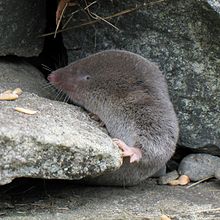Northern short-tailed shrew
| Northern short-tailed shrew[1] | |
|---|---|

| |
| Scientific classification | |
| Domain: | Eukaryota |
| Kingdom: | Animalia |
| Phylum: | Chordata |
| Class: | Mammalia |
| Order: | Eulipotyphla |
| Family: | Soricidae |
| Genus: | Blarina |
| Species: | B. brevicauda
|
| Binomial name | |
| Blarina brevicauda (Say, 1823)
| |

| |
The northern short-tailed shrew (Blarina brevicauda) is the largest
Taxonomy
B. brevicauda is a
Description

This shrew has a total length of 108 to 140 mm (4.3 to 5.5 in), of which 18 to 32 mm (0.71 to 1.26 in) is tail; and weighs 15 to 30 g (0.53 to 1.06 oz).
Distribution
Fossil record
Most records of B. brevicauda are from the Pleistocene,[7] though one record from the late Pliocene (Blancan land mammal age) is tentatively attributed to this species.[8] Another source indicates the earliest record of the genus Blarina is a specimen of B. b. talpoides, from the Blancan (early Pleistocene) in Kansas. The species is thought to have arisen in the middle or late Pliocene.[3] The B. b. brevicauda subspecies appeared later.[3]
Range
This shrew is found throughout central and eastern North America, from southern
Habitat
Both disturbed and undisturbed habitats are used by the northern short-tailed shrew, including grasslands, old fields,
Diet
This shrew consumes up to three times its weight in food each day.
Toxin
The saliva of the northern short-tailed shrew contains a kallikrein-like protease, used to paralyze and subdue its prey.[11] The toxin is strong enough to kill small animals, up to sizes somewhat larger than the shrew itself, and results in painful bites to humans who attempt to handle the shrew.[3] The venomous saliva is secreted from submaxillary glands, through a duct which opens at the base of the lower incisors, where the saliva flows along the groove formed by the two incisors, and into the prey.[3][5] The toxin is very similar in structure to the one produced by the Mexican beaded lizard (Heloderma horridum) which independently developed its toxin from the same precursor protein.[12]
Physiology
Senses
Their sense of smell is thought to be poor, and their eyes are degenerated and vision is thought to be limited to the detection of light,[3] but the shrew compensates by using echolocation and a fine sense of touch.[4][5]
Energetics
Its ability to consume almost anything it can catch allows the northern short-tailed shrew to survive the cold winters of
Behavior
Other shrews spend more time above ground than does the northern short-tailed shrew, which prefers to tunnel along below ground, through the
The shrew constructs a nest up to 20 cm (8 in) in diameter underground or underneath a log, and lines it with leaves or the fur of the
Typically
Reproduction
Mating occurs from March through September, though most births occur early or late in that period.[5] Male shrews in captivity were observed to make clicking sounds while courting a female.[15] During copulation, the male and female are locked together, and the female drags the male along with her.[3] Gestation lasts 21–24 days, and after birth, the six to eight young are suckled for up to 25 days before the babies are weaned.[3][5] Two litters per season are typical, though three are possible.[4] The female strengthens the nest when the young are nursing, and is more active to support her increased nutritional needs.[3] The young, which were born hairless and blind and weighing less than a gram, may become sexually mature in as soon as 2–3 months; those born in the spring mature more quickly than those born late in the season, and may themselves reproduce in the same year they were born.[3][5] The juvenile pelage is pale and quite similar to the adults' summer fur, and is molted when the young reaches adult size.[3]
Predation
The northern short-tailed shrew has a high mortality rate, though it attempts to escape predation by remaining hidden under vegetation, soil, leaf litter, or snow;
Conservation
The northern short-tailed shrew is considered a species of least concern in the IUCN Red List, as it is widespread, abundant, and its population is not declining.[2]
Relationship with humans
Northern short-tailed shrews cannot be
References
- OCLC 62265494.
- ^ . Retrieved 11 March 2022.
- ^ a b c d e f g h i j k l m n o p q r s t u v w x y z aa ab ac ad ae af ag ah ai aj ak "Mammalian Species Accounts: Northern Short-tailed Shrew (Blarina brevicauda)" (PDF). Retrieved 2024-03-12. Includes a range map.
- ^ a b c d e f g h i j "Animal Diversity Web: Blarina brevicauda". Retrieved 2008-11-23.
- ^ ISBN 978-0-472-06497-7.
- ^ S2CID 8438791, archived from the originalon 2013-01-05
- ^ "The Paleobiology Database - Blarina brevicauda". Retrieved 2008-11-23.
- ^ "The Paleobiology Database - Collection 19930". Retrieved 2008-11-23.
- S2CID 85875955.
- JSTOR 2425498
- PMID 15136743
- ^ Aminetzach et al. 2009
- ^ JSTOR 2425523
- ^ JSTOR 1381276
- ^ JSTOR 2424868
- JSTOR 2425153
- ^ "The Naming of the Shrew". 11 December 2017.
- Aminetzach, Yael T.; Srouji, John R.; Kong, Chung Yin & Hoekstra, Hopi E. (2009): Convergent Evolution of Novel Protein Function in Shrew and Lizard Venom. Current Biology

